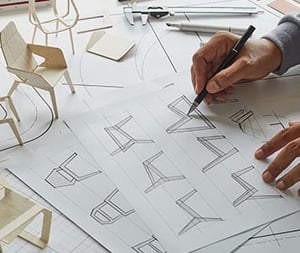Design rights: arrange them in advance and reap the benefits
 You need to be with it if you want to obtain the registered design rights - the protection of the external design of your invention - in good time. This is because the filing needs to be in order before you go public with it. And this while, if you do nothing, a design right will automatically arise when your product comes onto the market. So why should you nevertheless opt for a registered design right?
You need to be with it if you want to obtain the registered design rights - the protection of the external design of your invention - in good time. This is because the filing needs to be in order before you go public with it. And this while, if you do nothing, a design right will automatically arise when your product comes onto the market. So why should you nevertheless opt for a registered design right?
Design rights: two types
With a design right you can protect the design, the external appearance, of your invention. Others are then not allowed to copy it. There are two types of design rights: unregistered and registered.
An unregistered design right arises automatically when your product is brought to market within the EU. Take for example the external appearance of a new coffee machine which you have developed. When the device is launched you will be automatically protected for three years against copycats who knowingly copy your design. You will not have to do anything for that except bring it to market in the EU. Nice and easy. Or is it?
Protection via a registered design right, on the other hand, requires a prior filing. Together with a design attorney you have to submit a design application with drawings that clearly show the individual nature of the design of your coffee machine. Once you have gone through this procedure, the options with a registered design right are better than they are with an unregistered design right in nearly all cases. So if you are with it beforehand, you will reap the benefits later.
Advantages of a registered design right
Three years of protection without having to put in a great deal of effort may appear to be more appealing than investing time and money in an application for a registered design right but I nevertheless very much recommend that you do the latter and carefully consider your choice before bringing your product to market. Let me explain why.
First of all, three years is not actually very long. But what makes it particularly disadvantageous not to register is that if you have an unregistered design right, you will have to prove that a counterfeit version of your product has in fact been derived from your design. And that is not easy. Another inventor may have had the same idea and their design may look the same by accident or coincidence. However, if someone has deliberately copied your design you will still need to legally prove it.
In the case of a registered design right you will not have this problem. Whether it is the same design by accident or intention, you have the rights. Someone else can still come up with the same idea, but you will not have to prove that they were inspired by you. If the other person came up with the design after you, then that is simply bad luck for them. Furthermore, a registered design right is valid for 5 years, after which you can extend it 4 times for a further 5 years, up to a maximum of 25 years.
Right is on your side
Design rights apply to the design of all consumer goods: from garden furniture to hand blenders and from wireless headphones to chargers. These are things which you can buy on Amazon for example from countless suppliers. With a registered design right it is easier to approach a party like Amazon with the images of your registered design right. Then it will soon become clear that the supplier trying to sell the same coffee machine does not have the law on its side. You do.
Online shops do not like to burn their fingers on infringement cases like this and will therefore simply look at who has the design right. The supplier without a registered design right will then often be left behind.
Design rights: make a conscious choice
In almost all cases registered design rights are the best choice. In the fashion industry, where large numbers of garments are brought to market in a single collection, people often opt for unregistered design rights. Due to the large numbers and the short time in which a garment is on the market, this is a logical choice. For the majority of other products, it is not.
Whatever you choose, make sure you make a conscious choice. You can still apply for a design right up to one year after the launch of your product unless someone else has already done so. This means it is important to determine your strategy in advance to avoid surprises.
If you would like more information about design rights and what kind of protection would be best for you, please feel free to contact us for a no-obligation consultation. You can also do the design check on our website to see whether your design can be protected by a design right.
If you want to find out more about design protection, then also read these blogs about the advantages and the costs.

About the author
I studied mechanical engineering and materials science at Delft University. I joined EP&C as a trainee patent attorney in 2015 and qualified as a Dutch and European Patent Attorney in 2021. In...
More about Thomas >